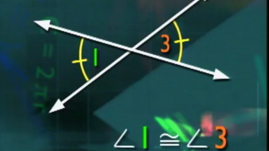Teachers' Domain - Digital Media for the Classroom and Professional Development
User: Preview



Vertical angles lie diagonally opposite one another at an intersection. Vertical angles are always equal in measure. When angles are equal in measure, we say they are congruent.
These resources are part of KET's Measurement and Geometry collection.
This video segment originally appeared in KET’s GED Connection series.
When two lines lie on a flat surface, they are parallel or else they intersect at some point. Parallel lines never meet or intersect. They remain an equal distance apart no matter how far they are extended.
On the other hand, intersecting lines do cross. When intersecting lines cross, they form four pairs of supplementary angles. A supplementary angle is formed when the sum of the measures of two angles equals 180o. At the intersection, the angles that lie diagonally opposite one another are called vertical angles. Vertical angles are always equal in measure. When angles are equal in measure, we say they are congruent.
Have learners draw intersecting lines on the board. Ask, “Which angles look equal? How could we prove they are equal?”
Use objects around the room (pencils, rulers, yardsticks) to have learners create congruent angles.
 Loading Standards
Loading Standards